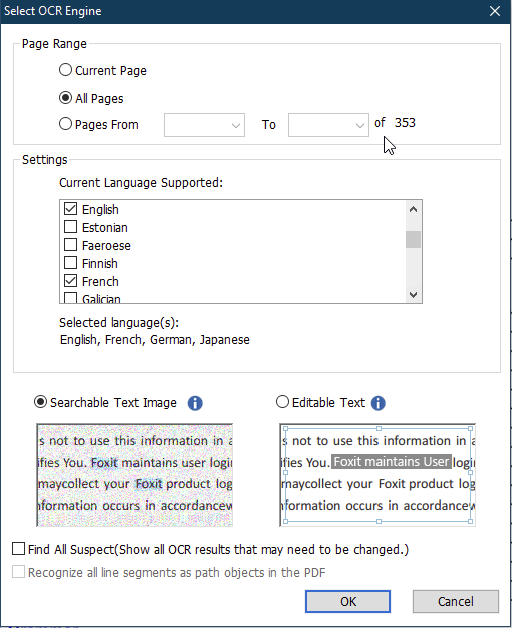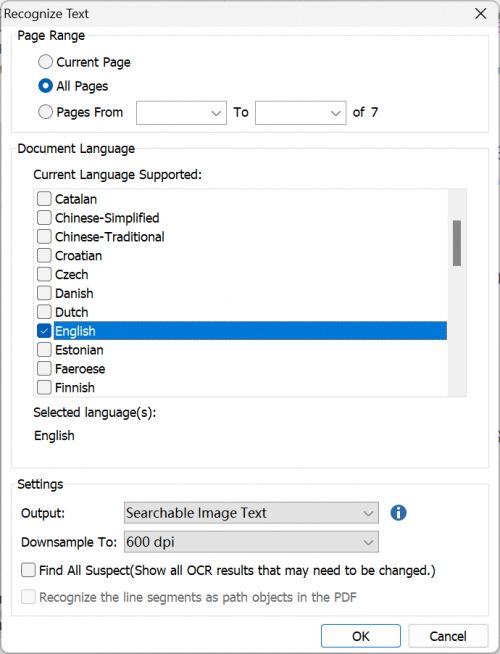- April 18, 2023
- Brad Selbst, Sales Vice President
In a previous article, we covered how to change the Foxit PDF Editor interface language. Now let’s look at some features you may want to use when working with multiple languages in one document and then we will look at some features that can help with multiple multilingual files at once, and we’ll even explore some other use cases.
Using OCR to convert multiple languages
In our global world, many businesses function across borders, relying upon multiple languages to get the job done. This is why Foxit PDF Editor supports multilingual Optical Character Recognition (OCR).
If you’re dealing with a document that’s not searchable (static image vs. live text) and contains multiple languages, you can translate it with Foxit PDF Editor.
To create a searchable PDF from a static document that has more than one language in it, simply do the following:
- Open the Convert toolbar by using one of the following methods:
- Click OCR > Current File.
- In the Select OCR Engine dialog box (shown below), do the following:
- Specify the page range to be OCRed.
- Select the language(s) used in your document.
- Choose the output type: 1) Searchable Text Image: Makes the image text searchable. 2) Editable Text: Makes the image text editable.
- Check Find All Suspects (Show all OCR results that may need to be changed.) option if you want the OCR suspects to be displayed for you to check and correct after the recognition.
- Click OK to start text recognition.

OCR multiple multilingual files at the same time
You’re not limited to converting multilingual documents one at a time.
To recognize text in multiple PDF files, do this:
- Open the Convert toolbar by one of the following:
- Click OCR > Multiple Files.
- In the OCR Multiple Files dialog box, do the following:
- Click Add files, and choose Add Files, Add Folder, or Add Open Files to add a file, folder, or opened file.
- After adding the files, use the Move up or Move Down button to reorder the files, if necessary.
- Click Remove to remove the added file from the list, if necessary.
- Click Output Options to select the destination folder and choose how to name the new file and whether to overwrite an existing one.
- Click OK.
- In the Select OCR Engine dialog box, select the language and output type, and click OK.

With Foxit PDF Editor, you can always find what you’re searching for, even if it’s in various languages.
Having Foxit PDF Editor speak other languages aloud
Read Out Loud uses the available voices installed on your system. If you have SAPI 5 voices installed from text-to-speech or language applications, you can choose them to read your PDFs.
Making documents accessible in other languages
Some screen readers read the text in the language specified for the document. Setting the Primary Language rule means that Foxit software checks whether the primary text language for the document is specified. If no language was set, only Foxit PDF Editor Pro allows you to fix this issue.
You can set the language by right-clicking the rule in the Accessibility Check panel in the navigation pane, choosing Fix from the context menu, then selecting a language in the Set Reading Language dialog box. You can also set the language manually by doing either of the following:
- Set the language for text in a subtree of the tags tree in the Tags panel. Right-click an element, choose Properties…, and select a language in the Object Properties dialog box.
- Set the language for a block of text in the Content panel. Right-click the text element or container element, choose Properties…, and select a language in the Object Properties dialog box.
Foxit has more than 700 million users worldwide who live in over 200 countries and speak many different languages. That’s why Foxit PDF Editor allows you to use other languages, giving you more choices to meet your language needs.

Hello,
I want to use foxit pdf trial. I have the free trial version. I would like to add something on the top of each page in Armenian language. As I go to “organize” section and there is place for adding some info at the top or buttom of the pages. But when I want to type Armenian letters sylfaen fonts, It does not type at all. but when I want to do it in another language, French or English etc. it works. Is there any possibilty to add the Armenian language for adding on the top of the pages SECTION, because in the regular cases when I want to change ARMENIAN words in a file, it does work in Armenian BUT FOR ADDING ON THE TOP oF PAGES IN THE SECTION “ORGANIZE” it does not work.
Could you please help me to find a solution, because it is very important for me to be able to insert words on the top of each page in Armenian.
Thank you in advance
Respectfully,
Hayk Hovhannisyan
Hi Hayk,
To add Armenian letters in the header section of a PDF document using Foxit PDF Editor, you can follow these steps:
1. Open the PDF document in Foxit PDF Editor.
2. Go to the “Edit” tab in the top menu.
3. Click on the “Header & Footer” button in the “Pages” group. This will open the Header & Footer toolbar.
4. In the Header & Footer toolbar, click on the “Add Header & Footer” button.
5. A text box will appear in the header section of the document.
6. Click inside the text box to activate it and start typing.
7. To add Armenian letters, you can use the Armenian keyboard layout on your computer. You can switch to the Armenian keyboard layout by pressing the language switch key (usually located near the Shift key) on your keyboard or by using the language settings on your operating system.
8. Type the desired Armenian letters in the text box.
9. Customize the font, size, alignment, and other formatting options using the options available in the Header & Footer toolbar.
10. Once you have added the Armenian letters and formatted the header text as desired, click outside the text box to save the changes.
The added Armenian letters should now appear in the header section of the PDF document. You can adjust the position and appearance of the header text using the options in the Header & Footer toolbar.
Please note that the availability of Armenian letters and font support may depend on the fonts installed on your computer and the PDF viewer used by the recipients of the document.
If none of these steps resolve the issue, you may need to contact Foxit customer support for further assistance. They will be able to provide more specific troubleshooting steps based on your specific situation.